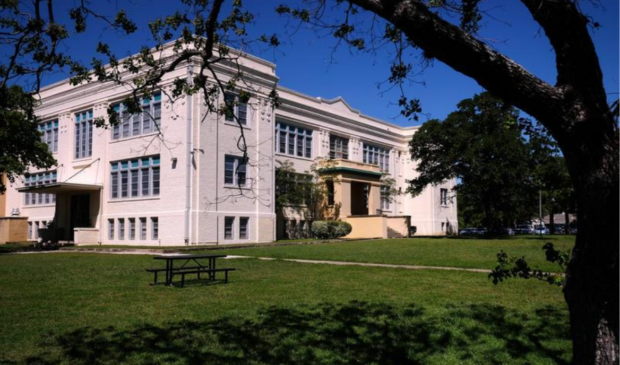Landmark commission OKs historic zoning for Baker School and its parking lots
Monday, November 30, 2020 by
Elizabeth Pagano The Historic Landmark Commission voted to zone the entirety of the Baker School property historic at its recent meeting, despite a staff-supported alternative that would omit the surrounding parking lots.
AISD sold the school, which was built in 1911, to the Alamo Drafthouse in 2018. At the time, the district explained it had accepted a lower bid on the property due to a promise to build affordable housing for teachers. The district was sued for accepting the bid, and the Drafthouse has since clarified the promise was to offer a percentage of any housing built as affordable, and that there was no promise to build housing. Now, the Drafthouse has returned to City Hall to seek historic landmark designation for the school.
Architect Richard Weiss spoke on behalf of the application for historic zoning at 3908 Avenue B. He told the commission that a portion of the property that had been rezoned to allow construction of a five-story affordable housing project had since been purchased by the city in order to build a detention pond.
Susan Moffat spoke in support of historic zoning for the Baker School, saying it would not preclude affordable housing on the site. “Historic zoning would only affect the building exterior and grounds. The 66,000-square-foot interior could be reconfigured for affordable units in the future.”
“It is a false choice to pit recognition of this one-of-a-kind landmark against affordability,” Moffat said. “Austin is capable of doing both.”
Though the Hyde Park Neighborhood Association voted in support of the historic zoning designation, its urbanist-leaning counterpart, Friends of Hyde Park, opposed the designation in a letter posted online. The group notes that a rezoning to make the school part of the neighborhood conservation combining district and its status as a contributing structure in the historic district already serve to protect the building.
The letter continues, “Making a property historic has been known to make it hard or impossible to add housing to any part of the property, even the parking lots. Parking lots cover a considerable amount of the Baker School property and could be a great way to add affordable housing around the existing building. Adding historic zoning on top of all of the other restrictions will be a huge loss to our neighborhood and Austin as a source for future affordable housing. If affordable housing is something that our city values, this zoning request will be soundly rejected.”
Historic Preservation Officer Steve Sadowsky told the commission that the school is “clearly” a historic landmark, but said his office had worked to come up with a designation that focused on the building, instead of enshrining the parking lots. The city staff recommendation is to zone the reduced parcel historic, with a 30-foot buffer around the school.
“This entire site is contributing to the historic district. To limit the historic zoning does not affect the authority of commission to review any changes anywhere on the site,” he explained.
However, commissioners disagreed, voting 9-1 in favor of designating the entire property historic. Commissioner Alex Papavasiliou voted in opposition and Commissioner Caroline Wright was recused.
“I think it’s really important,” Chair Terri Myers said. “I think that the site warrants this consideration.”
Before casting his vote in favor of historic zoning, Commissioner Witt Featherston said the new zoning was “not equitable.”
“Clearly the Baker School is worthy of historic zoning. I would have rather supported the zoning that was of the reduced parcel that staff recommended. But you know, I’m not going to vote against this,” he said. “I just want to say that the zoning is messed up.”
The city’s Planning Commission has since voted in favor of the historic zoning on a reduced footprint that includes the building and a buffer.
The Austin Monitor’s work is made possible by donations from the community. Though our reporting covers donors from time to time, we are careful to keep business and editorial efforts separate while maintaining transparency. A complete list of donors is available here, and our code of ethics is explained here.
You're a community leader
And we’re honored you look to us for serious, in-depth news. You know a strong community needs local and dedicated watchdog reporting. We’re here for you and that won’t change. Now will you take the powerful next step and support our nonprofit news organization?










